


Planetary Order
Imaging each of the following scenarios:
- A planet moves off course.
The Ganymede Hypothesis - Part 1: The Original Double Solar System
(Read the article on one page)
Consider the axis tilts of planets in our system. If our system had formed from a swirling disk of solar material as textbooks claim, all axial tilts should be approximately the same, that is, all near zero with all axes of the planets roughly perpendicular to the plane of orbit. The sun, Jupiter, and mercury do in fact show that. Uranus and Venus are odd cases out with their own explanations, but Neptune, Saturn, Mars, and Earth all have axis tilts of 23.4 - 27 degrees.
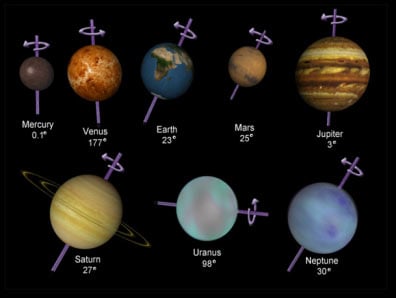 The explanation which suggests itself is as follows: Our sun, Jupiter, and Mercury, with their axes roughly perpendicular to the plane of the system, form one part of the ancient system; Uranus and Venus are odd cases with their own separate explanations; Neptune, Saturn, Mars, and Earth, with their spin axes roughly 26° to the plane of the system, comprise what once was a separate system, which must have been captured by our present sun as a group.
The explanation which suggests itself is as follows: Our sun, Jupiter, and Mercury, with their axes roughly perpendicular to the plane of the system, form one part of the ancient system; Uranus and Venus are odd cases with their own separate explanations; Neptune, Saturn, Mars, and Earth, with their spin axes roughly 26° to the plane of the system, comprise what once was a separate system, which must have been captured by our present sun as a group.
The normal reaction is to assume that this occurred hundreds of millions of years ago. Ancient literature says it occurred a few thousand years ago. Primitive people seeking to devise an astral religion today would end up worshiping the sun and moon, but the two chieftain gods of all antique religions were Jupiter and Saturn. Plato consistently refers to antediluvians as "Nurslings of Kronos(Saturn); the main religious festival in ancient Rome was "Saturnalia", our Sabbath is still called "Saturday". Hesiod and Ovid claim there was a golden age hen Saturn/Kronos was "King of Heaven", followed by the great flood, then a brief "Silver Age" when Jupiter/Zeus was "King of Heaven", followed by the Trojan war and our present "Iron Age". In the same language, our sun is the "King of Heaven" now.
Herbig-Haro objects and the way in which the axis tilts of the Saturnian part of our system came about
Herbig-Haro objects are believed to be associated with proto-stars in their infancy, and the accepted view is that these baby stars are shooting out vast polar jets of gas along their rotational axis in which globules or beads of plasma collect in our now familiar ‘string of pearls’ analogy. These so-called beads maintain their axial alignment and rotation in step with the proto-star exactly in the manner suggested for the Earth/Saturn polar configuration. Here, in fact, is the elusive evidence pointing to the possibility that polar configurations are possible in the depths of space.
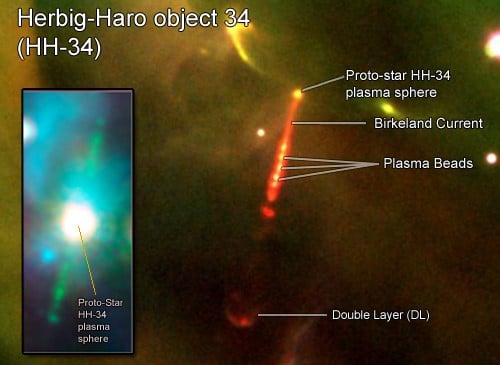 What mainstream scientists identify as polar jets of hot gas are, in fact, Birkeland currents, the great interstellar and interplanetary transmission lines for the flow of electrical energy through interstellar space. The beads of plasma collecting along these Birkeland currents are where z-pinches are taking place. Z-pinches are extremely stable areas into which heavy elements like iron, ejected from the proto-star or drifting in interstellar space, are attracted and captured due to the intense magnetic fields associated with z-pinches. Some of these z-pinches fail to spark into full-blown main-sequence stars, and instead produce brown dwarfs, They even may produce the solid cores needed for the formation of terrestrial-type planets — and all this is happening along the same axial alignment of their proto-star’s shared rotation.
What mainstream scientists identify as polar jets of hot gas are, in fact, Birkeland currents, the great interstellar and interplanetary transmission lines for the flow of electrical energy through interstellar space. The beads of plasma collecting along these Birkeland currents are where z-pinches are taking place. Z-pinches are extremely stable areas into which heavy elements like iron, ejected from the proto-star or drifting in interstellar space, are attracted and captured due to the intense magnetic fields associated with z-pinches. Some of these z-pinches fail to spark into full-blown main-sequence stars, and instead produce brown dwarfs, They even may produce the solid cores needed for the formation of terrestrial-type planets — and all this is happening along the same axial alignment of their proto-star’s shared rotation.
The so-called ‘bow-wave shocks’ supposedly produced by the hot gas shooting out along the proto-star’s polar axis are nothing more than what plasma physics calls a ‘Double Layer’. These double layers, or DLs, are the signature effect of a Langmuir sheath, or, in other words, a plasma sheath ; the same protective electrical cocoon we have already encountered when looking at the electrical environment surrounding brown dwarf stars. Their presence in Herbig-Haro objects is a dead giveaway that serious electrical activity is taking place, the kind of activity that produces intensely strong and attractive magnetic fields. Wherever you have powerful magnetic fields you have a recipe for potential planet and star-birthing activity; it is the magnetism at work that attracts heavy elements like iron to form a solid core.
It is this profusion of electrical activity that is most relevant to our assertion that Earth started off under Saturn according to this polar configuration model.
The lifespan of a Herbig-Haro object is relatively short, lasting in the tens of thousands of years. Things happen quickly where these objects are concerned, and they apparently begin to break up once the proto-star at its center develops into a fully-fledged main-sequence star like our current sun. Any brown dwarfs and their satellites attached to such a former proto-star will be released to form their own planetary nebula while finding their own way in space.
A brown dwarf star formed in this environment can be expected to maintain its own axially aligned Birkeland current even if it is severed from the main Birkeland current emanating from the main proto-star. Acting as a spinning homo-polar electric motor, or Faraday motor, the new brown dwarf star will generate its own electrical equilibrium as it feeds from the same general galactic electrical circuit that is also driving the main proto-star at the heart of the now breaking-apart Herbig-Haro object. In this way its axial tilt may change slightly, an important consideration when contemplating why Saturn came to have a different axial tilt to the Sun.
Part 2 : Dark and bright sides of the ancient system
Part 3 : Ganymede
By Ted Holden
Cosmos in Collision , a new book co-authored by Theodore A. Holden and Troy D. McLachlan, involves a startling claim: that the authors have pinpointed to within a statistical certainty the original home of modern humans on the largest of Jupiter’s moons, Ganymede. Hominid to human evolutionary schemes are shown to be unworkable; humans are shown to be highly maladapted to the conditions of this planet in very ancient times, implying that we could not plausibly have evolved or been created for this planet; Ganymede is shown to be the remains of what would have been a perfect world for Elaine Morgan’s “Aquatic Ape” thesis and for human habitation. By “to within a statistical certainty”, is meant that a zero probability event or probabilistic miracle would have to have occurred for anything other than what the authors are proposing, to have happened.
The Ganymede Hypothesis - Part 2: Dark and bright sides of the ancient system
(Read the article on one page)
Rocky planets orbiting a sub Brown dwarf star would orbit inside the plasma sheath or Heliosphere of the small star. Radiant energy would not be in short supply, but light would be and would be canted towards the blue and red extremes of the visible spectrum. At a later point in time, the earth acquired dust-laden auroral bands which blocked out almost all light from North temporal latitudes. Dwardu Cardona and other authors have described the curious lack of an ice age in the arctic. At least some parts of the Earth went from being very dark places to being very, very dark places.
The Sun and Jupiter in ancient times
When the discovery of exoplanets was first confirmed, it was natural that there would be a sampling bias towards finding large, gas-like giants since their enormous physical size made them easier to detect than smaller sized terrestrial-type planets like Earth. What was not anticipated, however, was that these huge gas giants, some many times the mass of Jupiter, would be found circling in extremely close orbits around their host stars. This fact is completely at odds with the accepted SNDM notion of planetary formation. The gravitational-based nebular model for the formation of a solar system calls for gas-giant planets to inhabit the system’s outer edges, while smaller terrestrial planets are expected to take up the innermost orbits. When Jupiter-sized planets, or ‘hot Jupiters as they were subsequently called, started appearing where Earth-like planets should be, journalists covering mainstream science started talking about going back to the drawing board:
As astronomers discovered the first extra-solar planets, it quickly became obvious that the formation theories that we’d built on our own Solar System were only part of the story. They didn’t predict the vast number of hot Jupiters astronomers found nearly everywhere. Astronomers went back to the drawing board to put more details into the theory , . . .(Emphasis ours)
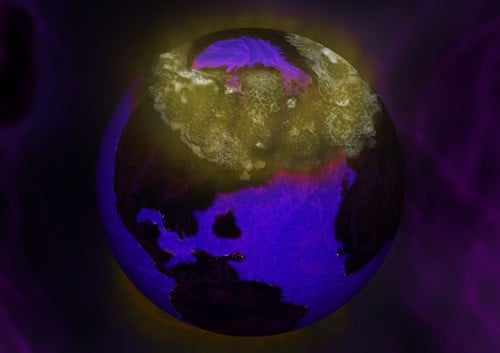 With gas-giant exoplanets now regularly discovered within 1 – 2 AU of their host stars, we now have growing data pointing to the common existence of gas-giants within the habitable zone of far-off distant sun-like stars - gas-giants not unlike our own Jupiter. It would not then be untoward to suggest that, given the then absence of the other major planets seen today, the Sun’s sole and original gas-giant, namely Jupiter, would most likely have been found in a much closer orbit to the one it currently holds, as seems to be the norm elsewhere. If such an orbit were within 1 – 2 AU of the Sun (where Earth is now), then it is reasonable to also suggest that Jupiter’s three currently ice covered moons, Europa, Ganymede, and Callisto, would have enjoyed liquid water environments spectacularly conducive to the existence of aquatic-based life had they also borne substantive atmospheres.
With gas-giant exoplanets now regularly discovered within 1 – 2 AU of their host stars, we now have growing data pointing to the common existence of gas-giants within the habitable zone of far-off distant sun-like stars - gas-giants not unlike our own Jupiter. It would not then be untoward to suggest that, given the then absence of the other major planets seen today, the Sun’s sole and original gas-giant, namely Jupiter, would most likely have been found in a much closer orbit to the one it currently holds, as seems to be the norm elsewhere. If such an orbit were within 1 – 2 AU of the Sun (where Earth is now), then it is reasonable to also suggest that Jupiter’s three currently ice covered moons, Europa, Ganymede, and Callisto, would have enjoyed liquid water environments spectacularly conducive to the existence of aquatic-based life had they also borne substantive atmospheres.
Creatures of the Saturnian (dark) system
Most if not all of the creatures of the Saturnian system, particularly dinosaurs and hominids, had larger eyes then we normally see in today’s land animals.
The eyes are the first thing a viewer notices with Danny Vendramini’s Neanderthal reconstructions:
Rob Gargett (the “Subversive Archaeologist ”) notes that if you draw a humanized Neanderthal with the eyes and nose as large as the bones indicate they would have to be, what you end up with is still outlandish:
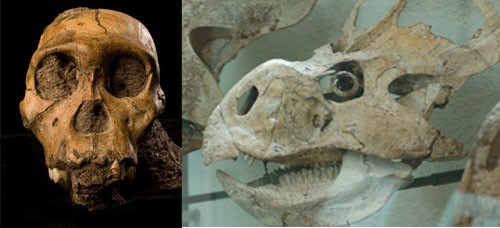
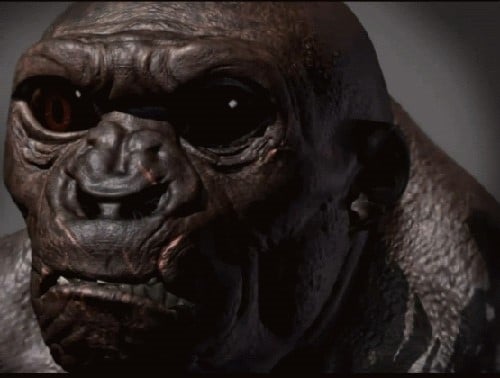
Image courtesy www.themandus.org
The Neanderthal, in fact, had a larger brain than modern humans do but was not inventive like modern humans. Given a creature with a larger brain than ours and tens of thousands of years to work with, one might expect to find Neanderthal cities; of course there aren’t any. New studies are indicating that:
...Results imply that larger areas of the Neanderthal brain, compared to the modern human brain, were given over to vision and movement and this left less room for the higher level thinking required to form large social groups...
In other words, the Neanderthal brain was dominated by what you might call the neurological equivalent of the circuitry for a military night-vision scope.

Image courtesy of Rob Gargett,
The Subversive Archaeologist Blogspot
Creatures of the Sun/Jupiter (bright) system
Such were the adaptations of creatures of the Saturnian system
Humans and Dolphins have the smallest relative eye sizes of higher creatures; both would be very bad candidates for having either evolved or been created for the Saturnian system .
The Human/Hominid non relation
Humans would have been maladapted to Earth’s ancient conditions in at least three ways, and these three problems would have been severe enough to rule out any sort of hominid to human evolutionary schemes. In other words, a hominid wishing to evolve into a human would need to have:
- Lost his fur coat while an ice age was going on.
- Lost 99% of his sense of smell while trying to make it as a prey animal on land.
- Lost almost all of his night vision at a time when night was the only time of day to be had.
We read (Paabo and Max Planck) that some (not all) modern human groups share Neanderthal genes and that this implies some level of interbreeding between our own ancestors and Neanderthals. Such claims have to be able to pass simple sniff tests for logic to be believable, and these claims don't; Cosmos in Collision goes into these questions in some detail.
What do humans need from an environment?
An original home world for humans would have to have been bright. Darkness mainly induces humans to sleep and human eyes would have been all but worthless in the conditions of the Saturnian system. Such an original world would also have needed to be wet. Elaine Morgan catalogued a fairly long list of features which humans share with the aquatic mammals.
- The most obvious visual difference between us and primates is the fact of our legs being our major limbs; that is basically an adaptation for swimming and wading.
- Voluntary control of our breathing is an example. That is basically an adaptation for swimming; we take it for granted but monkeys and apes don't have it, and that is the only reason that chimpanzees and gorillas cannot be taught to speak English; they can be taught to communicate using deaf signs fairly easily.
- Face to face sex is a behavioral characteristic of aquatic mammals. If any land animals other than humans do this, it’s very rare.
- Likewise sweating and the way in which humans use fat are maladaptive for a land animal but reasonable for an aquatic mammal.
There are numerous other such examples, i.e. the list is a fairly long one. Humans still show a preference for living around water. . Most of our major cities now stand on the shore of some body of water and ‘going to the beach’ is a worldwide trait amongst humans vacationing. Yet another measure of the extent to which humans still prefer living near water today can be had from the fact that something like 80% of the targets that the US military might ever want to engage were said to have been within the 25 mile range of the guns of the Iowa class battleships, that is, within 25 miles of some shoreline.
Elaine Morgan’s thesis has never gained any traction in academia and there are two main reasons. One is that no fossil evidence of any sort of an aquatic ape has ever been found. The other (and more serious) problem is that there has never been a body of water on this planet which would be safe for humans to live in.
An original home world for humans would need to have been bright; it would need to have been wet; and its waters would need to have been safe. A 10 minute tour of the ancient sea monster exhibit hall of the Smithsonian Museum should convince anybody that the prehistoric oceans of this planet would not qualify.
By Ted Holden
References
Dwardu Cardona, “Flare Star,” Traffid Publishing, Victoria, B.C., Canada, 2007, page 81; quoting R. F. Griggs, “Indications as to Climate Change From the Timberline of Mount Washington,” Science, Vol. 95, No. 2473 (1942), p. 519
Canadian astronomers Bruce Campbell, G. A. H. Walker, and Stephenson Yang announced in 1988 the first discovery of an exoplanet orbiting the star Gamma Cephei. This was subsequently fully confirmed in 2003. The 1992 discovery of two planets circling the pulsar PSR 1257+12 is generally recognized as the first fully confirmed discovery of an extra-solar planetary system.
Jon Voisey, Rocky, Low-Mass Planet Discovered by Microlensing, June 17, 2011, Universe Today.com; http://www.universetoday.com/86841/rocky-low-mass-planet-discovered-by-m...
BBC: “Neanderthals' large eyes 'caused their demise'” http://www.bbc.co.uk/news/science-environment-21759233
http://en.wikipedia.org/wiki/Neanderthal_genome_project, “In May 2010, the project released a draft of their report on the sequenced Neanderthal genome. Contradicting the results discovered while examining mitochondrial DNA, they demonstrated a range of genetic contribution to non-African modern humans ranging from 1% to 4%. From their Homo sapiens samples in Eurasia (French, Han Chinese & Papuan) the authors state that it is likely that interbreeding occurred in the Levant before Homo sapiens migrated into Europe”
The Ganymede Hypothesis - Part 3: Ganymede
(Read the article on one page)
Ancient Jupiter is elevated to the sub-stellar status of having once been a T-class sub-brown dwarf, enjoying a much tighter orbit around the sun within the latter’s so-called ‘habitable zone’. This revised orbital relationship is arrived at after assessing recent exoplanet data that shows growing numbers of Jupiter-like planets and suspected brown dwarfs in similar orbits around other sun-like stars. The data, we suggest, points to close orbiting Jupiter-like planets being the norm throughout the universe; this fact supports our hypothesis while contradicting currently accepted notions for gas-giant planet formation according to the accretion dictates of the Solar Nebular Disk Model (SNDM). Ganymede would have been warmed by both Jupiter and our Sun.
Brown dwarf stars and water
Jupiter’s reclassification as a former T-class sub-brown dwarf also provides a solution as to where all the water currently locked up as ice on the Galilean moons came from. Brown dwarf stars are known carriers of water and the misting and shedding of this water within a brown dwarf’s plasma sphere can be expected to settle on any rocky satellites orbiting within. It is precisely this scenario that we suggest for the origins of the vast amounts of water ice found on the Jovian satellites.
Fresh water oceans
Ganymede seems to be remarkably deficient in the element Sodium; i.e., salt.Sodium is thirteen times less abundant around Ganymede than it is around the other Jovian moon Europa. Io, Jupiter’s highly volcanic moon, is awash in sodium. However, Ganymede is not, and whatever small amounts of sodium have been detected on its surface is thought to have somehow found its way there from Ganymede’s supposedly deep salty ocean. Cosmos in Collision proposes nonstandard explanations for Ganymede’s conductivity, magnetosphere, and low moment of inertia.
Ganymede’s moment of inertia: water or pumice?
Ganymede’s ultra low moment of inertia is normally assumed to indicate a fantastically deep ocean, basically an outer mantel composed of salt water which supposedly accounts for both the low moment of inertia and the conductivity required for the magnetosphere. Cosmos in Collision postulates an outer mantel of pumice to explain the moment of inertia and p-holes to explain the conductivity.
Pumice bergs and islands
A fresh water ocean lies over top of the pumice outer mantel. Pumice actually can float. In the age when Ganymede was inhabited, there were floating burgs of pumice as well as anchored islands of pumice. Vegetation grew easily and well on these burgs and islands. Cosmos in Collision proposes that the Rocky lumps found in the present ice of Ganymede are remnants of these pumice burgs and islands.
Radiation: Ganymede’s magnetosphere
As mentioned above, Cosmos in Collision proposes a nonstandard explanation for Ganymede’s magnetosphere. It is worth noting that Ganymede alone amongst Jupiter’s Galilean moons has a magnetosphere. Of Jupiter’s Galilean moons: Io and Europa are inside Jupiter’s radiation belt; Callisto, outside of Jupiter’s radiation belt, would still experience radiation from the sun and shows no sign of ever having had an oxygen atmosphere; Ganymede, with its intrinsic magnetosphere, is safe from all radiation, shows signs of a past oxygen atmosphere, and in past ages would have amounted to a fresh water ocean paradise.
Capture of the Saturnian system and transfer
The sudden appearance of Cro Magnon man:
One thing scholars all agree on is that whatever caused Cro Magnon people to appear on this planet when they did was not gradual. Vendramini ("Them and Us") note.
The speed of the Upper Palaeolithic revolution in the Levant was also breathtaking. Anthropologists Ofer Bar-Yosef and Bernard Vandermeersch:
Between 40,000 and 45,000 years ago the material culture of western Eurasia changed more than it had during the previous million years. This efflorescence of technological and artistic creativity signifies the emergence of the first culture that observers today would recognise as distinctly human, marked as it was by unceasing invention and variety. During that brief period of 5,000 or so years, the stone tool kit, unchanged in its essential form for ages, suddenly began to differentiate wildly from century to century and from region to region. Why it happened and why it happened when it did constitute two of the greatest outstanding problems in paleoanthropology.
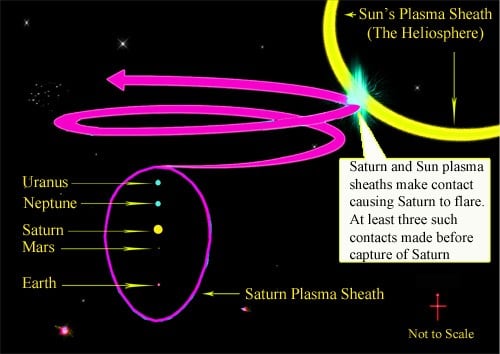 The Saturnian system did not approach our Sun in a straight line; it was a spiral approach and it was only at the points of near intersection the transfer of living creatures would have been possible. The multi-thousand year time lapse between the Cro-Magnon saltation and Genesis is thus explained as the time between two such near approaches.
The Saturnian system did not approach our Sun in a straight line; it was a spiral approach and it was only at the points of near intersection the transfer of living creatures would have been possible. The multi-thousand year time lapse between the Cro-Magnon saltation and Genesis is thus explained as the time between two such near approaches.
Cro Magnons and Bible Antediluvians
There appear to be two original basic human groups on our planet, i.e. Cro Magnons and Bible antediluvians. The two were all but genetically identical but the original cultures and technologies were completely different due to the time lapse. Both groups appear to be capable of producing any color or feature found amongst modern humans, i.e. the difference was/is not about color or race. Cro-Magnons thus account for the “Pre-Adamites” who Cain worries about in Genesis 4, and whose existence answers other biblical conundrums.
There is no way to believe that Adam, Eve, or any of the people in Genesis were descended from Cro-Magnonss. There is a list of things which the Bible and Jewish literature would have to know about were that the case. Aside from everything else, the people of Genesis were metal technology people from day one, i.e. that was never any kind of a Stone Age amongst them. Cosmos in Collision goes into these questions in some detail.
Occam’s Razor and other possibilities
In the absence of time machines, Cosmos in Collision makes heavy use of the logical principle called "Occam's razor.” Named after Friar William of Occam, the principle is generally understood to mean that of competing theories with equal explanatory power, the simplest should be preferred. In particular, given the immense distances between stars in our galaxy, in the presence of a completely plausible origin for modern man within our own solar system, theories involving saltations from other star systems are ruled out. Likewise the possibility of humans arising on something entirely like Ganymede, which has since been destroyed leaving no trace, is ruled out. In other words, for the Ganymede hypothesis to be wrong, one of two flavors of a probabilistic miracle or zero probability event would have to have occurred. That is, human saltation from interstellar space, or from a missing twin of Ganymede.
By ‘salt’ we refer to sodium in its various manifestations as what is called ‘rock salt’ and not to sodium chloride. Sodium is an alkali metal found in various minerals such as rock salt and is the sixth most abundant element in the Earth’s crust. A lack of sodium in Ganymede’s atmosphere is blamed on its magnetosphere which may be fending off energetic particles capable of creating the chemical transformations to produce sodium. Or it may simply be that Ganymede lacks sodium per sé.
See; Michael E. Brown, “A Search for a Sodium Atmosphere around Ganymede,” Icarus, Volume 126, Issue 1, March 1997, Pages 236-238.
Danny Vendramini “Them and Us”, Kardoorair Press (2009), PDF electronic edition, pages 22 – 23
Planetary formation in an Electric Universe
 How are planets, moons, asteroids, comets (active asteroids) formed in an Electric Universe?
How are planets, moons, asteroids, comets (active asteroids) formed in an Electric Universe?
The Thunderbolts EU model has very different ideas and thinking to sciences Nebular hypothesis (core accretion models, gravitation accretion theory etc) coming from the Big Bang theory.
The discovery of oxygen molecules from comet 67P has shown that standard science theory for cometary formation or solar nebular model formation has failed and will have to be seriously modified again.
Below are some quotes and links to Electric Universe sites about the formation theories of rocky planets, gas giants, asteroids etc (electric stars formation are investigated in another article). More information will be added as it is found. At the moment they nearly all seem to be from Wallace Thornhill so if you know of any more please comment below or contactwith the details.
Electric Universe theory of space bodies formation
Asteroids and comets are not formed from this gravitational disk model of the formation of the solar system. So any examination of comets and asteroids is not going to tell us about the birth of the solar system, it may tell us something about the recent history of the solar system.
And that is simple because during the capture process, a star capturing a large body, a planet or a system of planets around another star, will cause chaotic rearrangement initially of all those bodies. And that chaos involves electrically interchange between those bodies.
And those cosmic thunderbolts are the very thing that rips material from the surface of a planets or even a sub stella body and hurls it into space to form debris of all sorts, ranging from dust through to meteoroids, comets and asteroids. And even, it could be said, new moons and planets.
Wal Thornhill - Astronomers Have No Idea How Planets Form | Thunderbolts Space news
Below is the 2 minute video of the above quote, or click on the quote link to watch the full 10 minute youtube video.
This video below also explains how EU theory suggests planetary systems may have been formed.
EU theory: comets and asteroids formation
But of course the Electric Universe relies on the information extracted from the mytho historical record to show that the solar system was quite different in our recent past, to say within 10 to 20 thousand years. And part of that chaotic motion in the solar system resulted in the electrical machining of bodies, particularly Mars. And the very fact that we still receive meteorites from Mars is an indication that this reconstruction of the recent history of the solar system is correct.
There were kilometres of material in depth removed from the northern hemisphere of Mars and aslo ripped from the giant electrical scar called Valles Marineris on Mars. So, the asteroids and comets are made up from planetary material.It has always been recognised that asteroids show the features that are expected from matter which has been in differentiation and the processes on a larger planet. So the origin of asteroids from a planetary surface has been accepted for some time. But comets were supposed to be primordial leftovers. Neither comets nor asteroids are primordial.
Wal Thornhill - Ringed Asteroid Stuns Astronomers | Thunderbolts Space news
Satellite moons origins
The fact that [asteroid] Chariklo may have small moons, of course, has led to a further enforcement of a false idea that it may in turn lead to the formation of a small moon. In other words the dust and so on in the rings can coalesce to form a satellite. This has never been shown. In fact the collision between small particles only works up to a matter of a centimetre or so, before the collisions will tend to disintegrate those particles once again, so you can never form a solid moon from a ring of dust.
This theoretical formation of satellites from a ring of dust on a much larger scale is said to possibly explain the birth of our own moon in the early days of the solar system, as well as the origin of many of the other satellites around planets and asteroids.This is harking back to the same old story which is centuries old now. If the satellites were formed in such a way you would expect a neat gradation in properties of those satellites. We dont find that. Each satellite of Jupiter and Saturn is so different that you wonder whether they were actually formed in the same way and from the same body.
Wal Thornhill - Ringed Asteroid Stuns Astronomers | Thunderbolts Space news
Titan’s recent electrical birth, possibly resulting from a double layer overload within Saturn, also explains its homogeneous core. Electric Universe theory proposes that the progeny of stars or planets are not all born at the same time as the parent. They are born hierarchically at intervals and are electromagnetically ejected, typically from within the parent.
If Titan was ejected from Saturn in a paroxysm, then its atmosphere and surface features are the results of that catastrophic event. Its interior could be electrically charged, either from a continuous circuit connection with Saturn or because it retains a remanent discharging current flow. Possibly both. The small effects on Cassini could be electrical in nature.
Perhaps “slushy core” and “rocky interior” are outdated ideas. Could the deep places inside planets and moons possess double layers? If that is the case, then “gravitational effects” on Cassini might be from Titan exerting an electric force on the spacecraft.
Enigmatic Colossus | Thunderbolts TPOD
The possible birth of planet Venus
But Venus was also identified as a spectacular discharging comet in the ancient congregation of planets. What can be made of that? It can be explained if Venus was the latest child of Saturn. As explained earlier, Saturn shows the symptoms of having given birth recently. The birth would be triggered by a sudden change in Saturn’s electrical environment when it crossed from interstellar space into the Sun’s plasma envelope, or heliosphere. The voltage drop across the Sun’s plasma sheath would almost equal the full driving potential of the Sun, measured in tens of billions of volts. Rather than being an anode in the galactic discharge, Saturn would become a cathode in the Sun’s environment and subject to forming cathode jets. Saturn could be expected to ‘spit the dummy’ in such a circumstance! Venus was one such ‘dummy,’ ejected from the equator of Saturn. Saturn’s swift rotation delivered a ‘slap on baby’s bottom’ to Venus giving it a slow retrograde spin. The magnitude of the axial tilt of Venus to the ecliptic is much less than Saturn’s, which suggests that the Venusian orbit was tilted away from Saturn’s equatorial plane due to electrical capture forces acting on that dying star. We have abundant pictorial evidence that Venus was wrenched from its orbit in a polar direction shortly after it was born. (See the Egyptian “Eye of Ra” above).
This account explains many odd things about Venus; its slow retrograde spin; its hellish temperature, having being born recently from the core of a brown dwarf star; its thick atmosphere inherited from the brown dwarf and subsequently modified by cosmic discharges; and its equatorial scars caused by spectacular radial discharging, which was faithfully recorded by the petroglyph artists. Venus carried away significant charge from its parent so that it still has a ‘cometary’ magnetotail and its mountains glow with plasma discharges. Venus also shows a surprisingly young surface that gave rise to ad hoc theories of resurfacing events. They are unnecessary. Venus is a baby.
Cassini’s Homecoming | holoscience
EU theory of planetary formations

The 'Thunderbolts version' of the Electric Universe theory (or the main proposed and accepted EU theory) suggests that elements are being created or transmuted now by electromagnetic forces, especially by the plasma double layers. Not that most elements were created during the Big Bang and then by thermonuclear reactions in dying stars.
The EU theory suggests that Birkeland currents, combined with z-pinches and Marklund convection, and electrical stresses of stars may be where planets are created. Perhaps nearly instantly when birthed from a star?
It requires the expulsion, or “birth” of a fully formed proto-planet from the core of a star or gas giant ... The physicist, Peter Warlow, made the colorful comment in 1982 that we assume that planets are formed outside stars “for the ‘obvious’ reason – that’s where we find them.” However, “We humans, equally ‘obviously,’ are outside our mothers – yet we did not start there!” It is far simpler and infinitely more efficient if planets are “born” at intervals by the electrical ejection of charged material from the similarly charged interiors of larger bodies – gas giants from stars, and rocky planets from gas giants. We have circumstantial evidence for such a proposal in the binary stars found after a nova outburst. Also most of the rocky bodies in the solar system closely orbit a gas giant. Electrical ejection in a massive internal lightning flash answers the question of the source of the energy. It is not dispersive like an explosion. The electromagnetic pinch effect will produce a jet of matter, rather like a coronal mass ejection, only on a much grander scale. The result is a proto-planet plus a stream of gases and meteoric debris.
... Falk’s report notes that extrasolar giant planets are too close to their stars to have formed there from a protoplanetary accretion disk. Rather than question the protoplanetary accretion disk model, the obvious proposal is to have the giant planets migrate after their formation elsewhere. However, it does not explain the orbital eccentricities. In our solar system, Uranus and Neptune are too far from the Sun to have formed where we find them. Why have our giant planets seemingly migrated outward and the extrasolar planets inward? When theoretical expectations fail scientists are required to re-examine all of the assumptions in their models. However, that is not done when some assumptions have become self-evident truths.
... A far simpler explanation is that gas giant planets are born by electrical expulsion from a star in a nova outburst. How else should we expect to find an extrasolar planet whipping around its parent in a few days or in an eccentric orbit? Eccentric orbits should be short-lived. They hint at recent events in those distant planetary systems; perhaps the birth of a new planet.
Planet Birthing | holoscience
Just as stars are observed to do, gas giant planets may also expel a jet of matter during periods of electrical instability. Accretion of matter in the jet is mediated by the electromagnetic pinch effect and electrostatic deposition. Both of these mechanisms are far superior to accretion by impacts (tending to shatter and scatter instead of to accrete). Electrostatic deposition easily creates the layering seen in all rocky objects to date.
Cassini’s Homecoming | holoscience
In the process of growing in a galactic electromagnetic pinch, stars are prevented from becoming too massive by “budding off” other stars and gas giant planets. Some progeny remain to form binary or multiple star families. Others escape from their parent. All receive their share of energy from the galaxy. The most common stars in the galaxy are also the dimmest, the L-Type Brown Dwarfs. These stars have the “food” required for life present in their atmospheres. Such a dwarf star/gas giant may undergo a nova outburst to eject part of its core to form dense Earth-like planets and moons. If they remain close to the parent they may be enveloped within the “womb” of the stellar anode glow where it seems the principal conditions for life are present.
Other stars, other worlds, other life? | holoscience
Due to Marklund convection, stars have cores of heavy elements. Electric stars are not nuclear furnaces! They shine because they remain embedded in the galactic power grid. The decay of the z-pinch exposes the newborn star to a new electrical environment. The critical factor in the star’s stability is the current density at its photosphere. If it is excessive, the star may electrically “fission” into two or more pieces in order to expose a greater surface area and reduce the current density to a manageable level. Ejection of stellar matter produces a companion star or “gas giant.” That may explain the baffling number of multiple star systems and close-orbiting gas giant planets. Distantly orbiting gas giants, like those in our solar system are another story.
Dwarf stars are born in the same process, probably in larger numbers than the bright stars. They do not require to fission because their electrical stress is low, as evidenced by their light. They may form fewer multiple star systems by a different process—electrical capture—to be explained later.
Assembling the Solar System | holoscience
Velikovsky/Ackerman Model
For those who find the Thunderbolts EU model of planetary and solar system creation a bit radical or not possible as it is not based on accretion models or standard science theories then there is what is referred to as the V/A Scenario by John Ackerman. This appears to be based on Immanuel Velikovsky 'Worlds in Collision' ideas and modified with some Electric Universe related ideas. The V/A model seems to be more 'accretion' based than plasmas and z-pinches but is still radical when compared to the Nebula Hypothesis.
God King Scenario: Mercury birthed Mars
To show how those interested in the Electric Universe and Immanuel Velikovsky can have very varied ideas, the same as mainstream science or any field of interest, the proponent of the intriguing God King Scenario suggests a literally way out there idea of a more violent birth for Mercury, from and as the core of Mars. Gary Gilligans's ideas are plantary chaos and formation are based on the Velikovsky/Ackerman Model.
The Aten was originally the solid magnetic iron core of Mars. In a process involving electromagnetic forces involving Earth it was sucked out through the Valles Marineris (enormous scar on Mars) to become the planet Mercury. This almost incomprehensible event was first proposed by physicist and catastrophist J Ackerman ... The iron planet Mercury now covered in a thin layer (relatively speaking) of rocky debris. Origin of this debris, blasted off Mars and battled up as recorded in the numerous but unverified pharaonic battles.
The Birth of Mercury and the Demise of Mars | God King Scenario
Solar system formation?
The formation of our solar system is where it gets interesting and controversial amongst those interested in an Electric Universe. There are a number of scenarios for the origin and configuration of the pre/proto/early solar system. The main thunderbolts EU theory has its own controversial Saturn Configuration.
EU based Solar system formations include:
Velikovsky / Ackerman Scenario | everythingselectric
Wandering star and brown dwarf | everythingselectric
wandering stars and planets? | everythingselectric
Saturn Polar Configuration | everythingselectric





